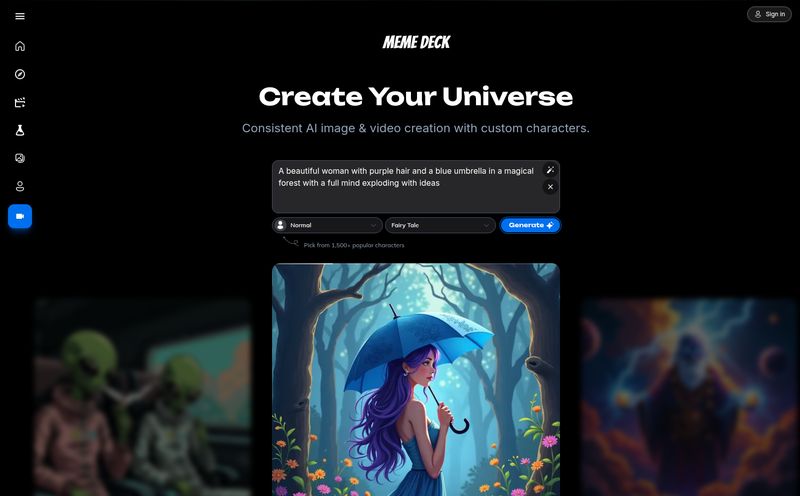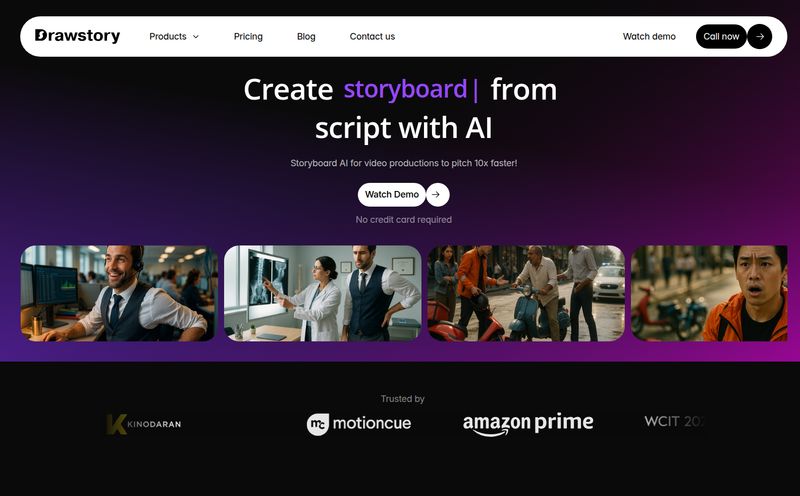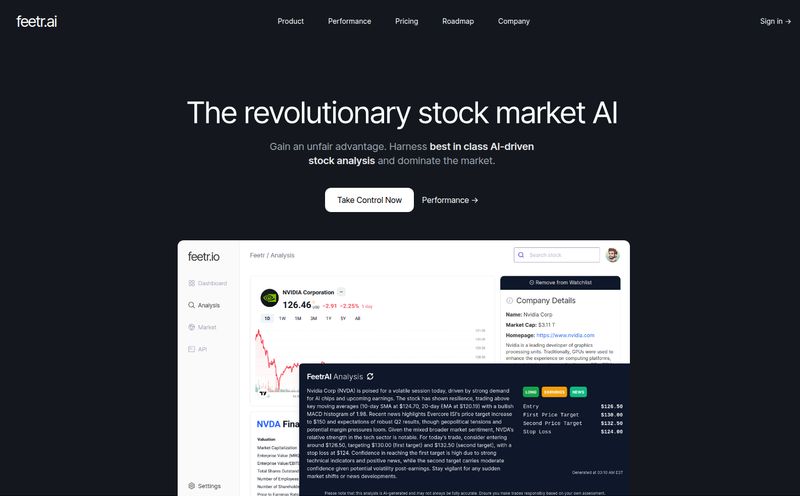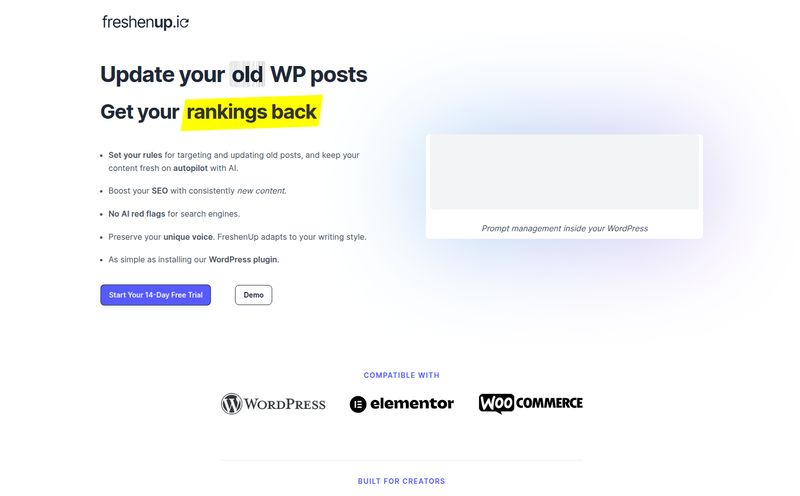The whole AI art scene exploded so fast it gave us all whiplash. One minute we were happy with our boring stock photos, the next we were surrounded by a tidal wave of six-fingered astronauts riding space dolphins. It's been a wild ride. As someone who lives and breathes digital content, I've tried more AI image tools than I can count. Most are either too complicated, requiring a PhD in prompt engineering and a local install that makes my laptop weep, or they're so watered-down the results look… generic.
So, when I stumbled upon Dreamlike.art, my first reaction was a healthy dose of skepticism. Another one? But the landing page was clean, no-nonsense, and promised “stunning original art in seconds.” Okay, you have my attention. I decided to dive in, and honestly, I'm glad I did.
First Impressions of Dreamlike.art
Logging in, the first thing I noticed was the interface. It’s a sleek, dark-themed dashboard that just gets out of your way. On the left, you have your creative cockpit: prompt boxes, model selection, and all the little toggles and sliders an AI artist could want. On the right, a gallery of your creations. No clutter. No confusing menus. It just felt… intuitive.
The best part? It’s all in your browser. There's nothing to download or install. This is a massive win for those of us who don't want to wrestle with Python dependencies and command-line interfaces. For a lot of people, the technical barrier to entry for tools like Stable Diffusion is a total non-starter. Dreamlike.art completely removes that hurdle.
What is This Thing, Exactly?
At its core, Dreamlike.art is a web-based platform that uses the powerful Stable Diffusion model to generate images from text prompts. But here’s the kicker and the reason it’s so speedy: it runs on server-grade A100 GPUs. For anyone not fluent in hardware specs, just know this is the equivalent of having a supercomputer do the heavy lifting for you. It means you aren't relying on your own computer’s power, and the generation process is ridiculously fast. It’s the difference between waiting minutes for an image and getting it in seconds. That speed is a creativity game-changer.
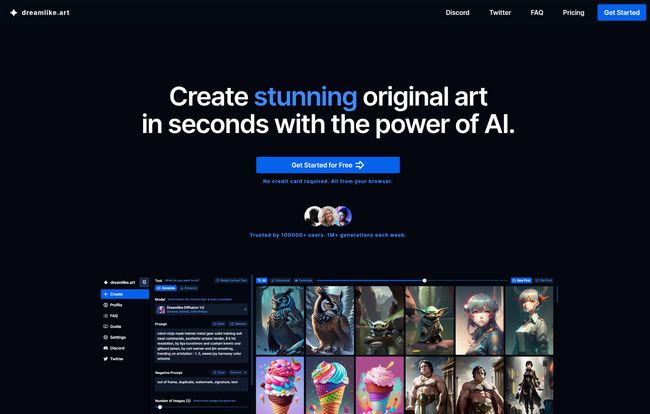
Visit Dreamlike.art
The Core Features That Actually Matter
A tool can have a million features, but only a few really move the needle. Here’s what stood out to me on Dreamlike.art.
The Magic of Text-to-Image Generation
This is the bread and butter. You type what you want to see, and the AI makes it. I started with something simple: “a photorealistic cat wearing a tiny wizard hat, sitting on a pile of ancient books.” The results were genuinely impressive. The platform also includes a “Negative Prompt” box, which is just as important. This is where you tell the AI what you don’t want to see—things like “blurry, extra limbs, bad quality.” It’s a simple feature that gives you a surprising amount of control over the final output.
More Than Just a Pretty Picture: Upscaling and Fixing
One of the biggest frustrations with AI art is getting a fantastic concept that's too small or has a slightly… weird face. We've all seen them. The uncanny valley portraits. Dreamlike.art has built-in tools to combat this. The Image Upscaling feature lets you increase the resolution of your favorite generations, making them usable for blog headers or high-quality prints. Then there's the Face Fix tool. It’s an automated process that cleans up distorted faces, turning a creepy creation into a plausible portrait. This saves an incredible amount of time you’d otherwise spend re-rolling prompts or trying to fix things in Photoshop.
Playing with Different AI Models
Dreamlike.art isn’t a one-trick pony. It offers multiple AI models, each with its own distinct style. Think of them like different lenses for your camera or different types of paint. You might use one model for creating realistic photos, another for anime-style characters, and a third for dreamy, abstract art. Being able to switch between these on the fly means you can match the visual style to your specific project without having to jump to a different platform.
Let's Talk Speed: Is It Really That Fast?
Yes. And it’s probably the platform's biggest selling point. That access to high-end GPUs means that even complex prompts are rendered in seconds, not minutes. However, there’s a catch. Your speed depends on your plan. Free users are on “low priority” generation, meaning when the servers are busy, you go to the back of the line. Paid users get “high priority,” which is essentially a fast-pass to the front. In my experience, even the low-priority queue wasn't terrible during off-peak hours, but if you're working on a deadline, the high-priority access is non-negotiable.
The Big Question: What Does Dreamlike.art Cost?
Alright, let’s get down to the brass tacks. The platform runs on a credit system, which is pretty standard for these kinds of services. The good news is, there's a plan for pretty much every budget.
I’ve always felt the best tools offer a genuinely useful free tier, not just a crippled demo. Dreamlike.art does a pretty good job here. The Free Plan gives you 24 credits per day. That’s enough to experiment, generate a few images for a blog post, and get a real feel for the platform. It's a generous appetizer that actually lets you taste the food before committing to the full meal.
When you're ready to get serious, the paid plans offer a lot more firepower. Here’s a quick breakdown:
| Plan | Price (Billed Yearly) | Credits /mo | Key Features |
|---|---|---|---|
| Free | $0 /mo | 24 /day (~720 /mo) | Low priority, queue up to 5 images |
| Core | $12 /mo | 3,000 | High priority, queue up to 10, all features |
| Pro | $24 /mo | 12,000 | High priority, queue up to 20, all features |
| Ultra | $48 /mo | 30,000 | High priority, queue up to 30, all features |
Note: Monthly prices are slightly higher if you don't opt for annual billing.
The Good, The Bad, and The Arty
No tool is perfect, right? After spending a good amount of time with Dreamlike.art, here’s my honest take.
What I loved is pretty clear: the raw speed is exhilarating. The browser-based interface makes it accessible to everyone. And the big one for me, as a content creator, is the fact that you can use the images commercially, even on the free plan (always check their latest content policy, of course). That is huge. So many free tools slap a non-commercial license on everything, making them useless for business.
On the flip side, the limitations of teh free plan are noticeable. Being in a low-priority queue can test your patience if you're in a hurry. The credit system, while fair, means you always have one eye on your balance. It’s not an all-you-can-eat buffet, which forces you to be a bit more deliberate with your generations. But is that really a bad thing?
Who Should Be Using Dreamlike.art?
This is where the rubber meets the road. I see a few groups getting a ton of value here.
- Bloggers and Social Media Managers: Stop using the same three stock photos everyone else is. Create perfectly tailored, unique featured images and social posts in minutes.
- Indie Developers & Writers: Need concept art for a character, a location, or an item? This is an incredible tool for rapid visualization and brainstorming.
- Marketers and Small Business Owners: Create custom visuals for ads, presentations, or your website without hiring a graphic designer.
- Curious Creatives: If you've been wanting to try AI art but were intimidated by the tech, this is your entry point. It's fun, it's fast, and the barrier to entry is practically zero.
Frequently Asked Questions about Dreamlike.art
1. Can I really use the images I create for my business?
Yes, according to their policy, you can use images commercially on all plans, including the free one. This is a major advantage. However, it's always a good idea to review their specific Content Policy to ensure your use case is compliant.
2. What is Stable Diffusion, anyway?
In simple terms, Stable Diffusion is a powerful open-source AI model that creates images from text descriptions. Dreamlike.art provides a user-friendly interface and the computing power to run this model effectively without you needing any technical expertise.
3. Do I need a powerful computer to use Dreamlike.art?
Not at all. Since everything is processed on their powerful servers, all you need is a device with a modern web browser and an internet connection. Your own computer's specs don't matter.
4. How do the credits work?
Credits are the currency of the platform. Generating a standard image typically costs 1 credit. More advanced actions, like upscaling or using more complex settings, might cost more. Your plan determines how many credits you get each month (or day, for the free plan).
5. Is Dreamlike.art better than Midjourney or DALL-E?
"Better" is subjective. Midjourney is known for its highly artistic and stylized output but lives inside Discord, which some users find clunky. DALL-E is incredibly powerful but can be more expensive. Dreamlike.art's strength is its combination of speed, ease of use through a web UI, and a very competitive pricing structure, especially with its commercial-use-friendly free tier.
My Final Thoughts
After putting Dreamlike.art through its paces, I'm walking away impressed. It successfully bridges the gap between raw power and user-friendliness. It democratizes access to high-end AI image generation, wrapping it in an interface that anyone can master in minutes.
Is it the most powerful, infinitely-tweakable AI art tool on the planet? Maybe not for the hardcore tweaker who wants to build their own models from scratch. But for the 99% of us—the bloggers, marketers, artists, and curious minds who just want to create amazing images without the fuss—it's an absolutely fantastic option. It's fast, capable, and the value proposition is hard to argue with. If you've been sitting on the AI art sidelines, Dreamlike.art is a welcoming and powerful place to start.
